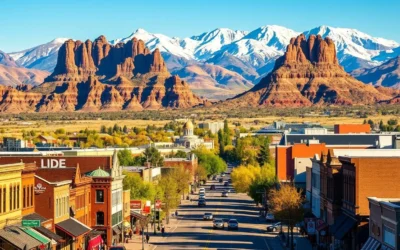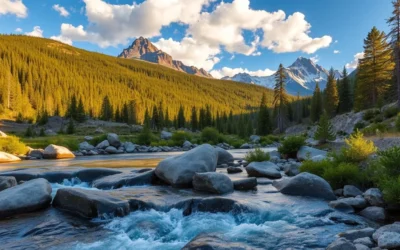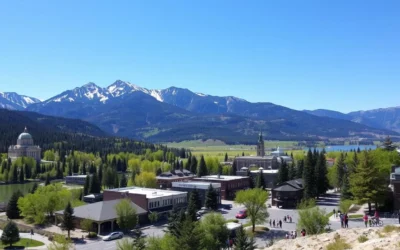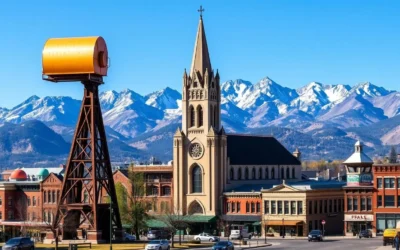On August 17, 1959, a powerful earthquake struck southwest Montana, causing widespread destruction and loss of life. The Hebgen Lake Earthquake, as it came to be known, had a magnitude of between 7.5 and 7.8 on the Richter scale.
This significant event led to the formation of Earthquake Lake, also known as Quake Lake, a unique geological attraction that showcases the region’s dramatic history and natural beauty. As you visit this fascinating destination, you’ll discover a blend of attractions and experiences that highlight the powerful forces that shaped the landscape.
The lake was created when a massive landslide dammed the Madison River, resulting in a 6-mile long body of water. As you explore Earthquake Lake, you’ll find opportunities to engage with the area’s history and enjoy the stunning mountain scenery, making it a must-visit destination for those interested in geology, outdoor recreation, or simply taking in the beauty of nature.
The Dramatic History of Earthquake Lake
In 1959, a massive earthquake struck Hebgen Lake, triggering a chain of events that led to the formation of Earthquake Lake. This earthquake, known as the Hebgen Lake earthquake, was a pivotal moment in the region’s history, causing widespread destruction and altering the landscape forever.
The 1959 Hebgen Lake Earthquake
The 1959 Hebgen Lake earthquake was a powerful seismic event that struck the area on August 17, 1959. The earthquake’s impact was felt across a wide area, with the most devastating damage occurring immediately downstream of Hebgen Lake. Here, 80 million tons of rock broke off a mountain and crashed into the Madison Valley, instantly wiping out a campground filled with sleeping campers and taking 21 lives.
The impact was so massive that it created hurricane-force winds strong enough to toss cars like toys and was heard as a loud “boom” in towns as far as 46 miles away. The earthquake’s force was so immense that it shook windows far beyond the immediate area, leaving a lasting impact on the region.
Formation of Earthquake Lake
The massive landslide triggered by the earthquake created a natural dam on the Madison River, which quickly began to fill with water. As the water level rose, it formed what is now known as Earthquake Lake, a 6-mile long body of water. The newly formed lake posed a significant threat to downstream communities due to the risk of the natural dam failing.
To mitigate this risk, the Army Corps of Engineers quickly dug a channel to prevent the dam from breaking and causing catastrophic flooding downstream. This project took over a month to complete, ensuring the safety of the surrounding area and road networks.
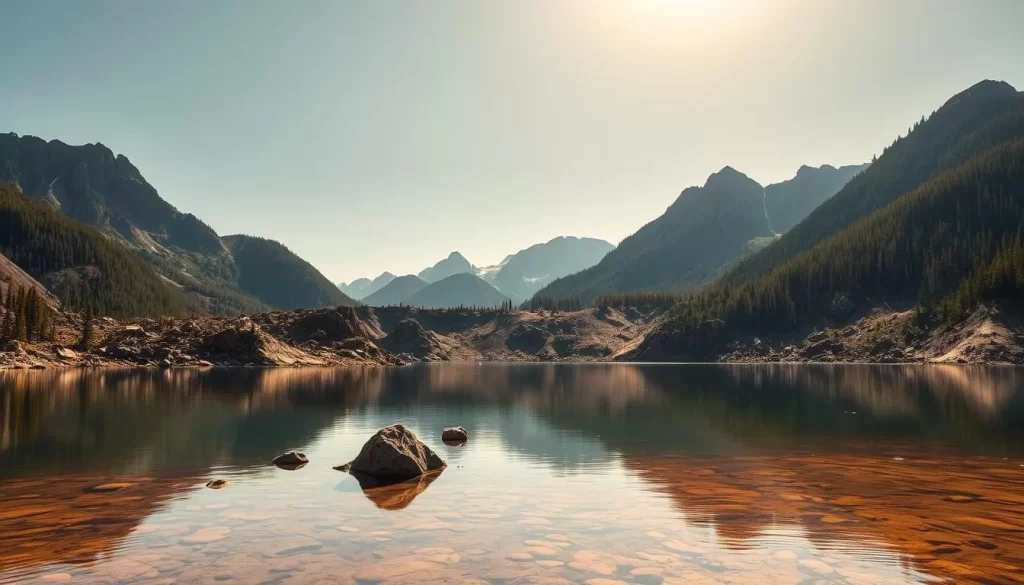
The formation of Earthquake Lake is a significant geological event that continues to fascinate visitors today. As you explore the area around the lake, you’ll discover more about the dramatic history and the natural processes that shaped this unique landscape.
Earthquake Lake Visitor Center
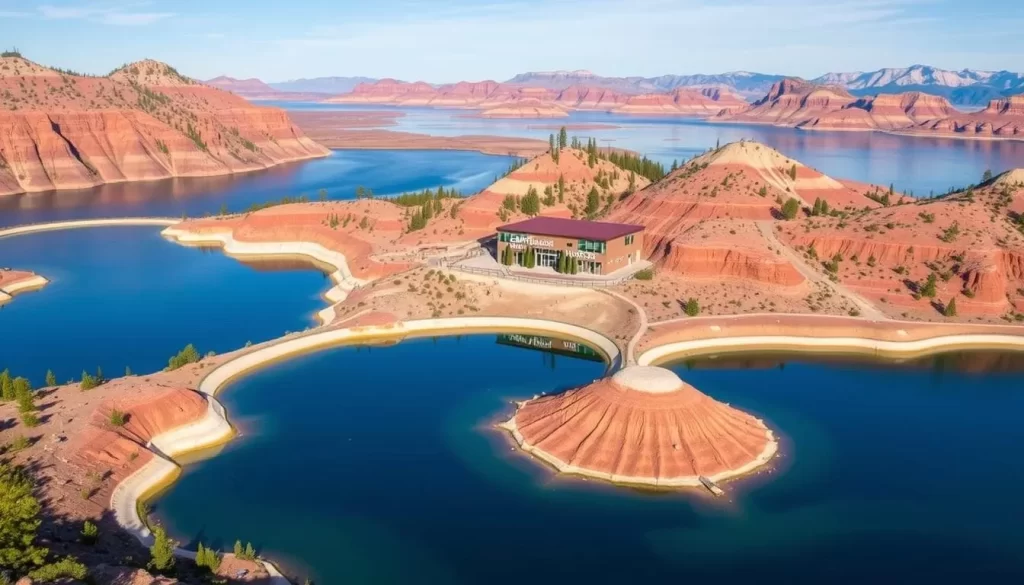
To grasp the magnitude of the 1959 Hebgen Lake earthquake, a visit to the Earthquake Lake Visitor Center is essential. The center provides a wealth of information about the earthquake and its aftermath, making it a crucial stop for anyone looking to understand this significant event.
Exhibits and Displays
The Earthquake Lake Visitor Center features a variety of exhibits and displays that detail the events surrounding the earthquake. Visitors can explore the history of the earthquake, its impact on the local environment, and the subsequent formation of Earthquake Lake. The exhibits are designed to be informative and engaging, offering insights into the geological processes that shaped the area.
Memorial Boulder and Viewing Platform
Outside the visitor center, several walking trails take you to significant landmarks, including the Memorial Boulder and a viewing platform. The Memorial Boulder, a large rock that was part of the landslide, now serves as a permanent memorial to the 21 campers who lost their lives. The viewing platform offers a panoramic view of the slide area, giving visitors an appreciation for the scale of the disaster. You can:
- Pay your respects at the Memorial Boulder.
- Explore several walking trails around the visitor center that lead to various viewpoints.
- Enjoy an incredible view from the viewing platform.
These trails are well-maintained and suitable for visitors of all ages, making the area accessible to everyone. The trails also offer a unique opportunity to explore the area affected by the landslide, providing a deeper understanding of the event’s impact.
Exploring the Earthquake Lake Geologic Area
As you venture into the Earthquake Lake Geologic Area, you’ll uncover the fascinating geological and historical significance of this region. The area offers a unique blend of natural beauty and educational opportunities, making it a compelling stop for visitors to the Yellowstone National region.
Scenic Drives Along Highway 287
A scenic drive along Highway 287 is a great way to experience the Earthquake Lake Geologic Area. The highway winds through the Madison River Canyon, offering breathtaking views of the surrounding landscape. As you drive, you’ll notice the dramatic changes in the terrain that resulted from the 1959 earthquake.
The drive is not just visually stunning; it’s also an educational experience. You’ll have the opportunity to stop at various points along the way, taking in the history and geology of the area.
Interpretive Displays and Turnouts
One of the highlights of visiting the Earthquake Lake Geologic Area is the numerous interpretive displays and turnouts along Highway 287. These displays bring the earthquake’s story to life through photographs, diagrams, and firsthand accounts, providing a deeper understanding of the geological processes that shaped the area.
A particularly fascinating turnout features a paved pathway leading to partially submerged cabins that were instantly covered when Hebgen Lake’s shoreline shifted during the quake. This unique attraction is among the most educational attractions in the Yellowstone National region, offering visitors of all ages an engaging way to learn about this significant geological event.
| Feature | Description | Location |
|---|---|---|
| Scenic Drive | A drive along Highway 287 through the Madison River Canyon | Highway 287 |
| Interpretive Displays | Displays featuring photographs, diagrams, and firsthand accounts of the earthquake | Along Highway 287 |
| Partially Submerged Cabins | Cabins covered by water due to the earthquake’s impact on Hebgen Lake’s shoreline | Accessible via a paved pathway from a turnout on Highway 287 |
Hiking Trails Around Earthquake Lake
Immerse yourself in the natural beauty of Earthquake Lake by exploring its numerous hiking trails.
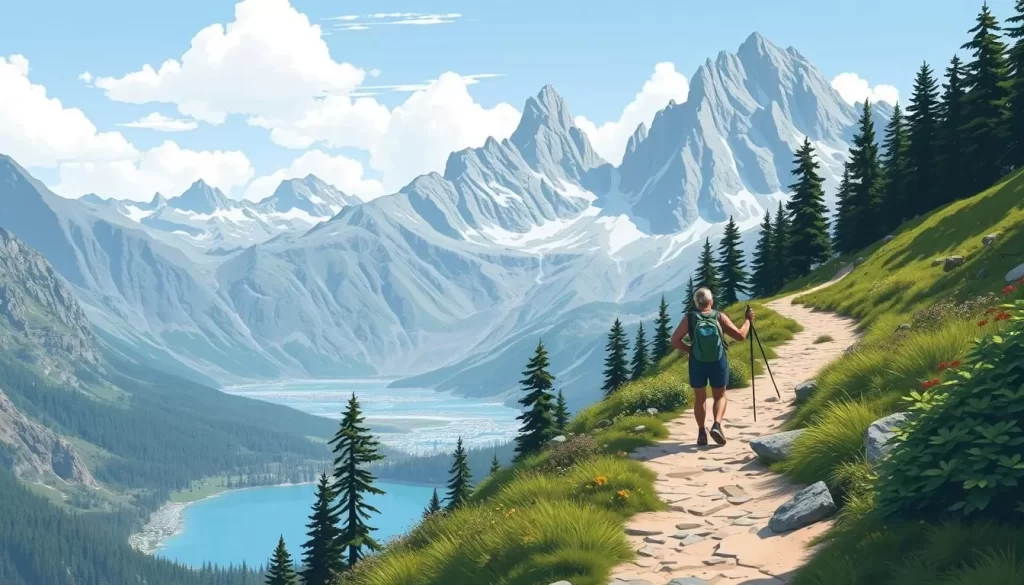
The Earthquake Lake area offers several hiking trails that cater to different skill levels and interests. Whether you’re looking for a leisurely walk or a more challenging hike, there’s something for everyone.
Earthquake Lake Trail
The Earthquake Lake Trail is a must-visit for anyone interested in understanding the geological history of the area. This trail takes you through areas dramatically altered by the 1959 earthquake.
Key Features: Interpretive signs explaining geological changes, scenic views of the lake.
As you walk along this trail, you’ll gain insights into the region’s seismic past and appreciate the natural beauty that has emerged since the earthquake.
Madison River Canyon Trail
The Madison River Canyon Trail offers a fascinating hiking experience along the renowned Madison River, known for its blue-ribbon trout fishing. You’ll walk through areas transformed during the 1959 earthquake, with interpretive signs along the way.
- The trail provides excellent wildlife viewing opportunities, with frequent sightings of deer, elk, moose, and various bird species.
- You can access several fishing spots along the trail, making it ideal for combining a morning hike with an afternoon of fishing.
- The relatively flat terrain makes this trail accessible for hikers of all skill levels.
Both trails offer unique experiences, allowing you to appreciate the natural and geological significance of the Earthquake Lake area.
Fishing Opportunities at Earthquake Lake
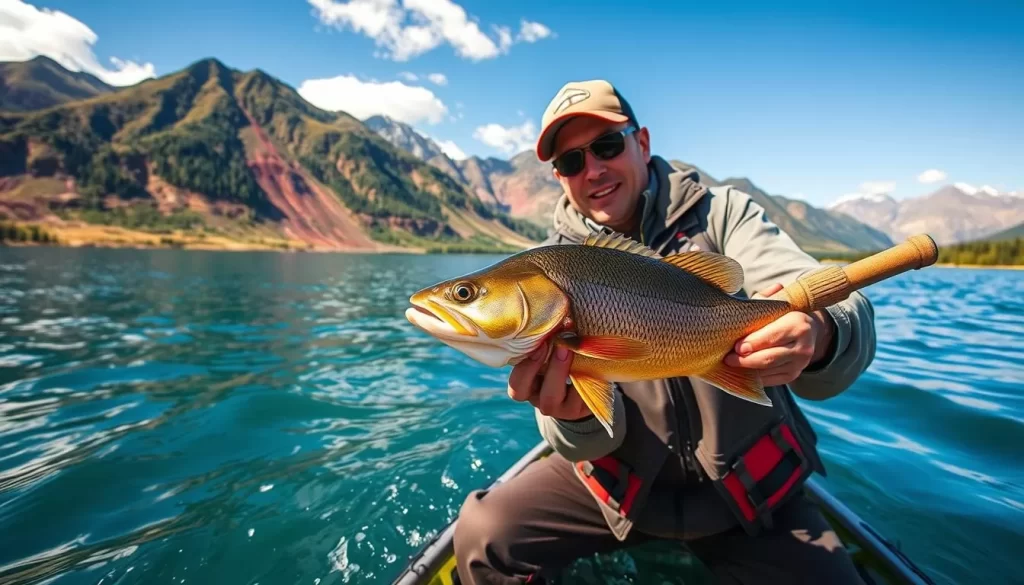
If you’re an avid angler, Earthquake Lake in Montana is a must-visit destination for its exceptional fishing experiences. The lake, formed by the 1959 Hebgen Lake earthquake, offers a unique blend of natural beauty and diverse fishing options.
Best Fishing Spots
The Earthquake Lake area is dotted with numerous excellent fishing spots. You can try your luck in the lake itself or explore the surrounding waters. The prime areas include the lake’s main body and the Madison River arm, where you can catch various trout species.
- You have multiple options for fishing approaches, including fly fishing, spin casting, or trolling from a boat.
- Some areas allow motorized boats, though there may be restrictions in certain parts of the lake.
Fishing Seasons and Regulations
Before you start fishing, it’s crucial to be aware of the local regulations. A valid Montana fishing license is required, as per Montana Fish, Wildlife & Parks regulations.
- The prime fishing season typically runs from late spring through early fall, with summer offering the most consistent conditions and comfortable temperatures.
- Be aware of specific catch-and-release requirements for certain trout species, as conservation efforts are important in this unique ecosystem.
- Winter ice fishing is not recommended on Earthquake Lake due to unstable ice conditions caused by underwater springs and the lake’s relatively recent formation.
Wildlife Viewing and Photography
Earthquake Lake’s unique landscape supports a wide variety of wildlife, making it an ideal location for nature lovers and photographers. The area’s diverse ecosystems provide a fantastic setting for observing animals in their natural habitats.
Common Wildlife Species
The Earthquake Lake area is home to a range of wildlife species. You can expect to see:
- Elk and deer grazing in the meadows near the base of the mountain slide area.
- Various bird species, including waterfowl and birds of prey.
- Other mammals such as beavers, muskrats, and occasionally, black bears.
These species can often be spotted in their natural habitats, providing excellent opportunities for wildlife viewing and photography.
Best Times and Locations for Wildlife Spotting
The best time for spotting wildlife is during the golden hours of early morning and late afternoon when animals are most active. Spring and fall are particularly rewarding seasons for wildlife viewing, as animals are either emerging from winter hibernation or preparing for the colder months.
To maximize your chances of spotting wildlife, consider the following tips:
- Bring binoculars and a telephoto lens for your camera to safely observe wildlife from a distance.
- Be patient and stay quiet to avoid disturbing the natural behaviors of the animals.
- Find a comfortable spot with good visibility and give yourself plenty of time to observe.
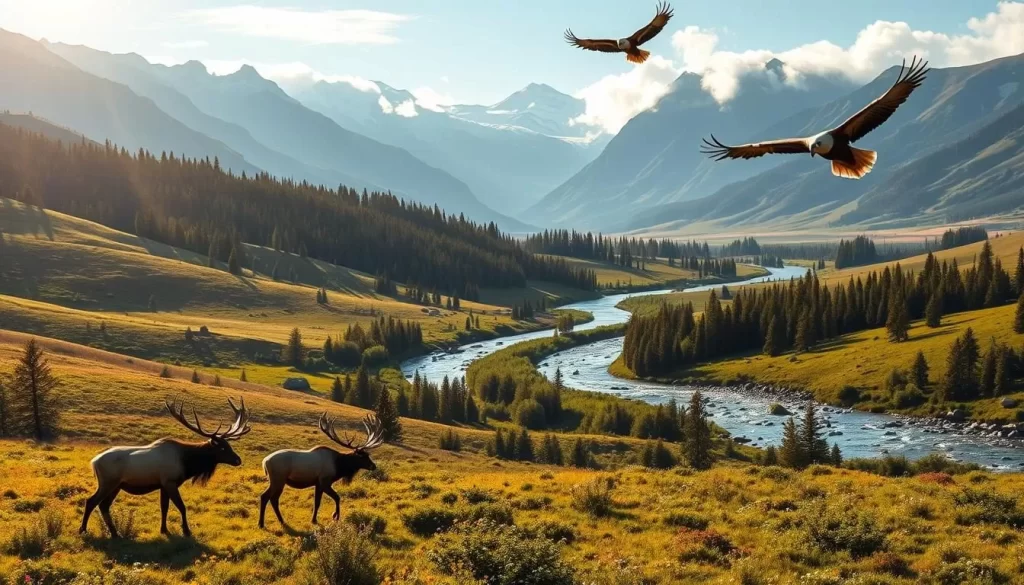
Earthquake Lake, Montana: Best Things to Do – Top Picks for Water Activities
Visitors to Earthquake Lake can indulge in various water activities that make the most of the lake’s unique setting. The lake’s formation due to a natural disaster adds a layer of intrigue to the experience.
Boating and Kayaking
Earthquake Lake is a perfect spot for boating and kayaking during the summer months. The lake’s calm waters offer a serene environment for paddling and exploring. You can rent kayaks or bring your own boats to navigate the lake’s many coves and inlets.
- Enjoy the tranquility of the lake’s waters, surrounded by the scenic beauty of Montana’s landscape.
- Explore the numerous coves and inlets, discovering hidden gems along the shoreline.
- Keep an eye out for wildlife, as the lake is home to various species of birds and fish.
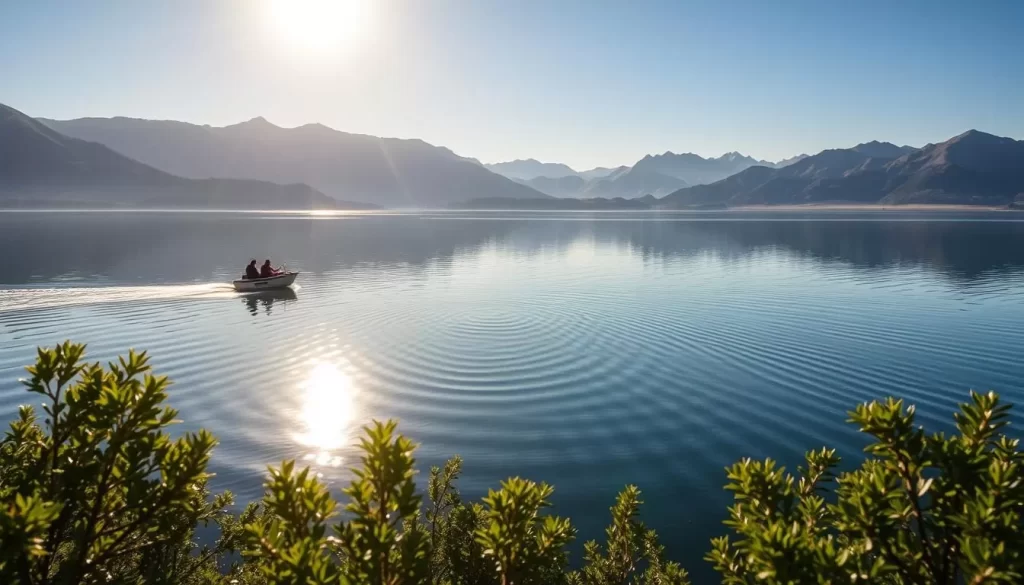
Swimming and Water Safety
When it comes to swimming, it’s essential to exercise caution. The waters of Earthquake Lake remain cold even during the peak summer months due to its depth and mountainous location.
- Be aware of the lake’s cold water temperatures, even on warmer days, particularly in areas away from the shoreline.
- Watch out for submerged trees and other underwater hazards, remnants of the 1959 earthquake.
- Always wear safety gear, such as life jackets, during water activities to ensure a safe experience.
By being mindful of these factors, you can enjoy a refreshing swim in this unique lake, making for a memorable experience.
Camping Near Earthquake Lake
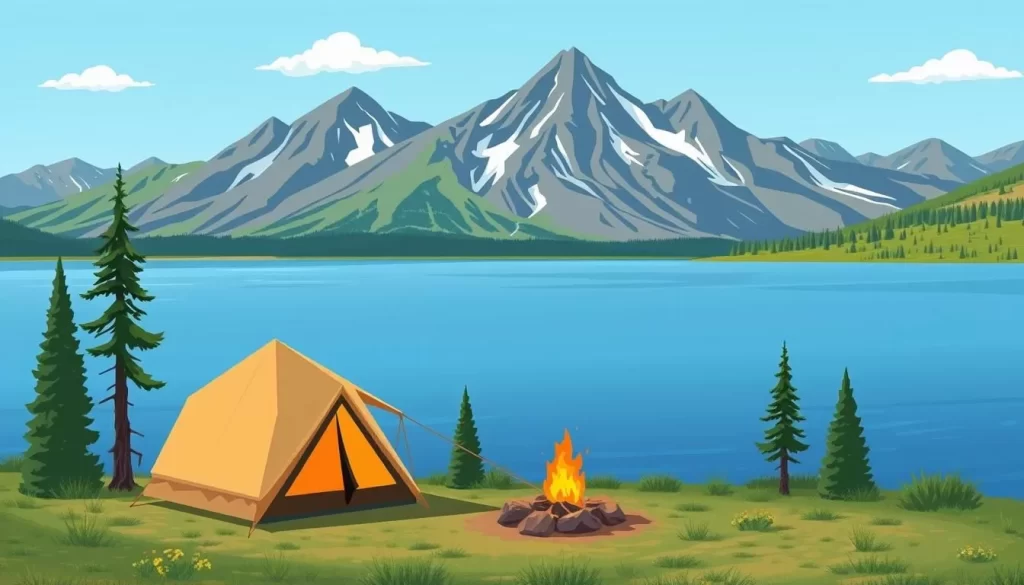
The area around Earthquake Lake provides an ideal setting for camping, with its stunning landscapes and outdoor activities. As you plan your trip to this beautiful region, you’ll find several options for camping that cater to different preferences and needs.
Campgrounds and Facilities
Several campgrounds are available near Earthquake Lake, offering a range of facilities to enhance your camping experience. These campgrounds vary in size and amenities, from basic sites with vault toilets to those with more developed facilities, including potable water and picnic tables. When you’re planning your trip, it’s essential to choose a campsite that suits your needs and to make reservations in advance, especially during peak season.
Tips for Camping in the Area
To ensure a safe and enjoyable camping experience near Earthquake Lake, keep a few tips in mind.
– You should make reservations well in advance if you’re planning to camp during the peak summer season, as the limited number of campsites in this popular area fill quickly.
– Bear-proof food storage is essential in this region, so always secure your food and scented items properly to avoid unwanted wildlife encounters.
– The weather can change rapidly in this mountainous area, so pack layers and rain gear even if the forecast looks favorable for your trip.
– Campfires may be restricted during dry periods and fire danger, so check with rangers about current conditions at the time of your visit.
– Consider camping during weekdays or shoulder seasons (late spring or early fall) if you prefer a quieter experience and have a better chance of finding your ideal camping place.
By following these guidelines and being mindful of your surroundings, you can have a memorable and enjoyable camping experience near Earthquake Lake.
Day Trips from Earthquake Lake
For those looking to explore beyond Earthquake Lake, several fantastic day trip destinations await. The area is rich in natural beauty and historical significance, offering something for every interest.
Hebgen Lake
Hebgen Lake is a nearby destination that offers a serene escape with opportunities for fishing and boating. The lake’s crystal-clear waters are surrounded by scenic landscapes, making it a perfect spot for a relaxing day trip. You can enjoy water activities or simply take in the views.
West Yellowstone
West Yellowstone, Montana, is the perfect gateway to Yellowstone National Park and is just a short drive from Earthquake Lake. This charming town is filled with natural beauty, wildlife, and outdoor adventures. Visitors can explore its many attractions, including museums and historic sites, before heading into the park.
Yellowstone National Park
A day trip to Yellowstone National Park is a must when visiting Earthquake Lake, given its proximity via the West Entrance. The park’s famous geothermal attractions like Old Faithful and Grand Prismatic Spring offer a fascinating contrast to the geological forces that created Earthquake Lake. Your trip to Yellowstone can include wildlife viewing opportunities, with chances to spot bison, elk, and possibly wolves or bears.
![]()
| Destination | Distance from Earthquake Lake | Main Attractions |
|---|---|---|
| Hebgen Lake | Nearby | Fishing, Boating, Scenic Views |
| West Yellowstone | Short Drive | Museums, Historic Sites, Outdoor Adventures |
| Yellowstone National Park | 30 miles via West Entrance | Geothermal Attractions, Wildlife Viewing, Natural Wonders |
Seasonal Activities and Best Times to Visit
From the warmth of summer to the chill of winter, Earthquake Lake is a year-round destination that caters to all kinds of outdoor enthusiasts. You can enjoy a variety of activities and breathtaking landscapes, regardless of the time of year you choose to visit.
Summer Fun
Summer is a peak season for visiting Earthquake Lake, with warm weather making it ideal for hiking, fishing, and water activities. You can explore the numerous hiking trails, enjoy a day of fishing in the lake, or simply take in the scenic views. The Visitor Center is open, providing valuable insights into the area’s history and geology.
- Hike the Earthquake Lake Trail or the Madison River Canyon Trail.
- Enjoy fishing or boating on the lake.
- Visit the Earthquake Lake Visitor Center for educational exhibits.
Fall Colors and Wildlife
As summer fades into fall, the area transforms with vibrant autumn colors, making it a picturesque destination for photographers and nature lovers. The changing foliage, combined with the area’s wildlife, offers a unique and serene experience. You can enjoy the fall colors while spotting deer, elk, or birds.
- Witness the fall foliage and capture it through photography.
- Spot local wildlife such as deer and elk.
- Take a scenic drive along Highway 287.
Winter and Spring Experiences
Winter brings a serene silence to Earthquake Lake, with snow covering the landscape. While some roads may be impassable, and the Visitor Center is closed, you can still enjoy winter activities like snowmobiling, cross-country skiing, and snowshoeing for those prepared for backcountry conditions. In the spring, as the snow melts, the area comes alive with wildflowers, and the spring runoff creates dramatic water flows in the Madison River, offering unique experiences for photographers and nature enthusiasts.
- Engage in snowmobiling, cross-country skiing, or snowshoeing in winter.
- Witness the renewal of spring with blooming wildflowers.
- Capture the dramatic spring runoff in the Madison River.
Conclusion
With its unique history and diverse wildlife, Earthquake Lake is an ideal place to experience the best of Montana’s great outdoors. As you reflect on your visit, you’ll find that the lake’s dramatic origin story and the visible evidence of the 1959 earthquake create an educational experience unlike any other in the region.
The area offers a wide range of activities, from hiking and fishing to boating and wildlife viewing, making it a great destination for outdoor enthusiasts. Its proximity to West Yellowstone and Yellowstone National Park also makes it an ideal addition to your Montana trip itinerary.
Whether you’re drawn to the area’s beauty, its fishing opportunities, or simply the chance to witness nature’s power, Earthquake Lake offers something special for every visitor. No matter what time of year you visit, the lake stands as a powerful reminder of how quickly the landscape can change and how nature recovers and adapts over time.
In conclusion, Earthquake Lake is a must-visit attraction in Montana, offering a unique blend of natural beauty and historical significance. As you plan your trip, consider adding Earthquake Lake to your itinerary for an unforgettable experience.
The above is subject to change.
Check back often to TRAVEL.COM for the latest travel tips and deals.

